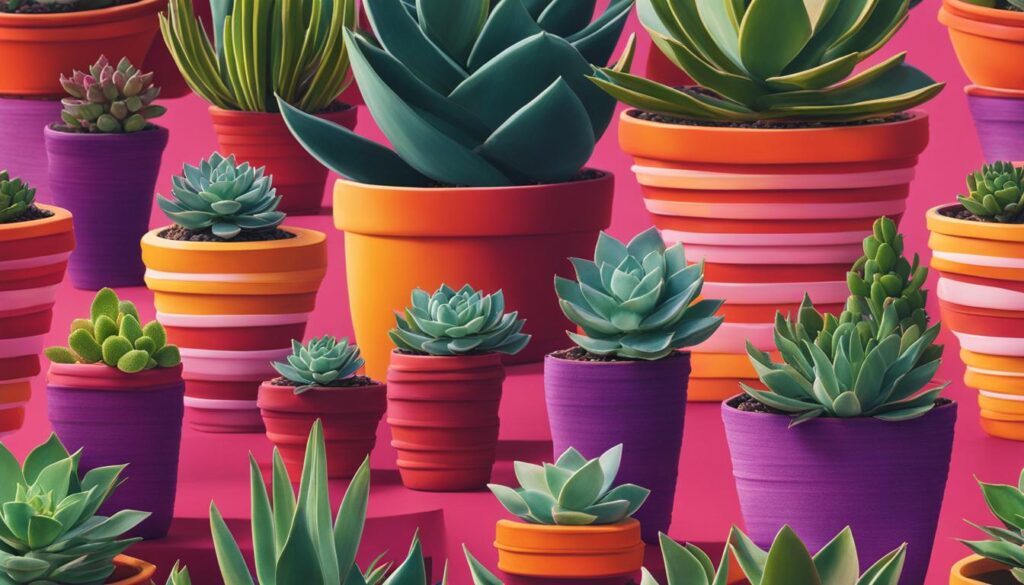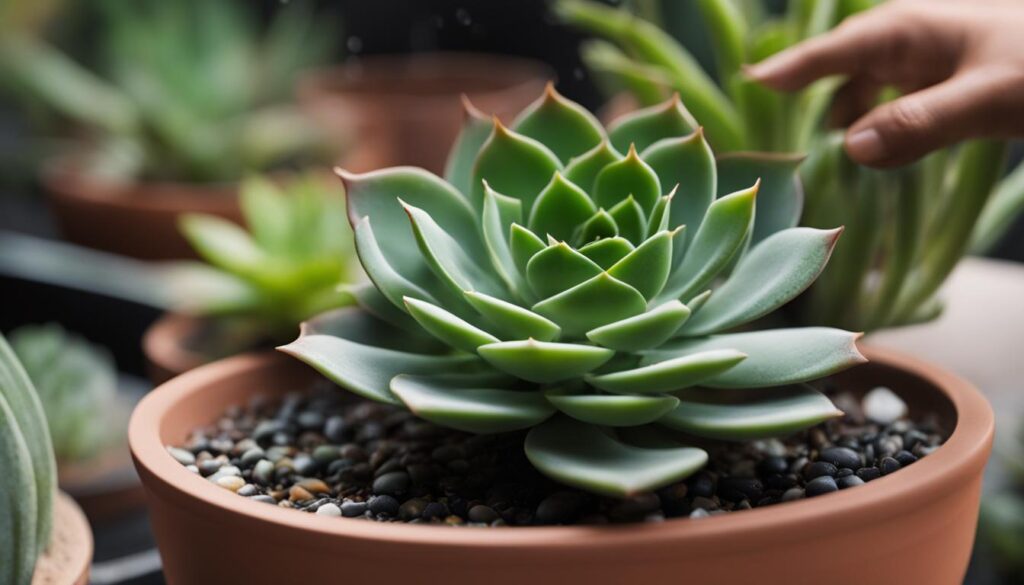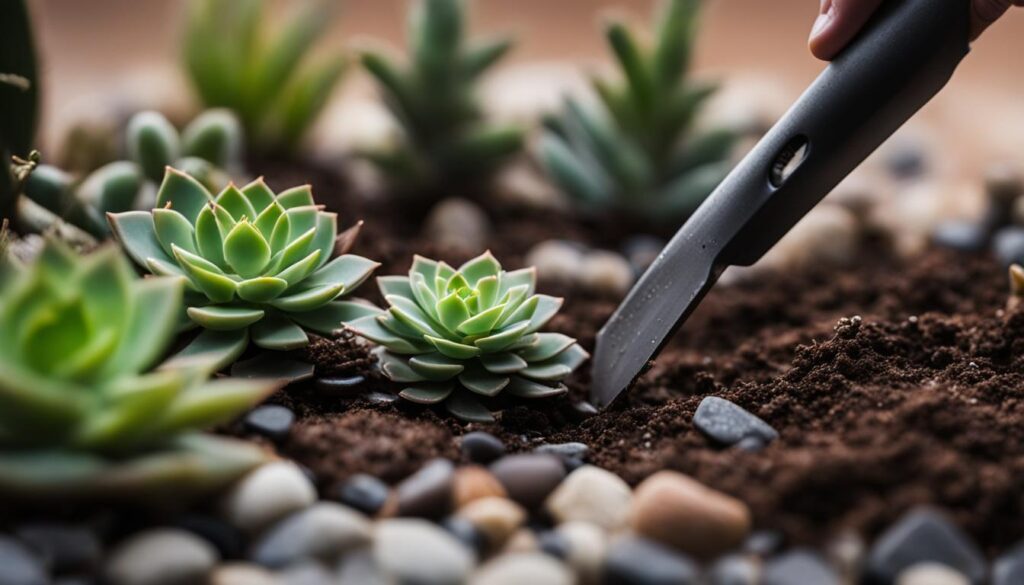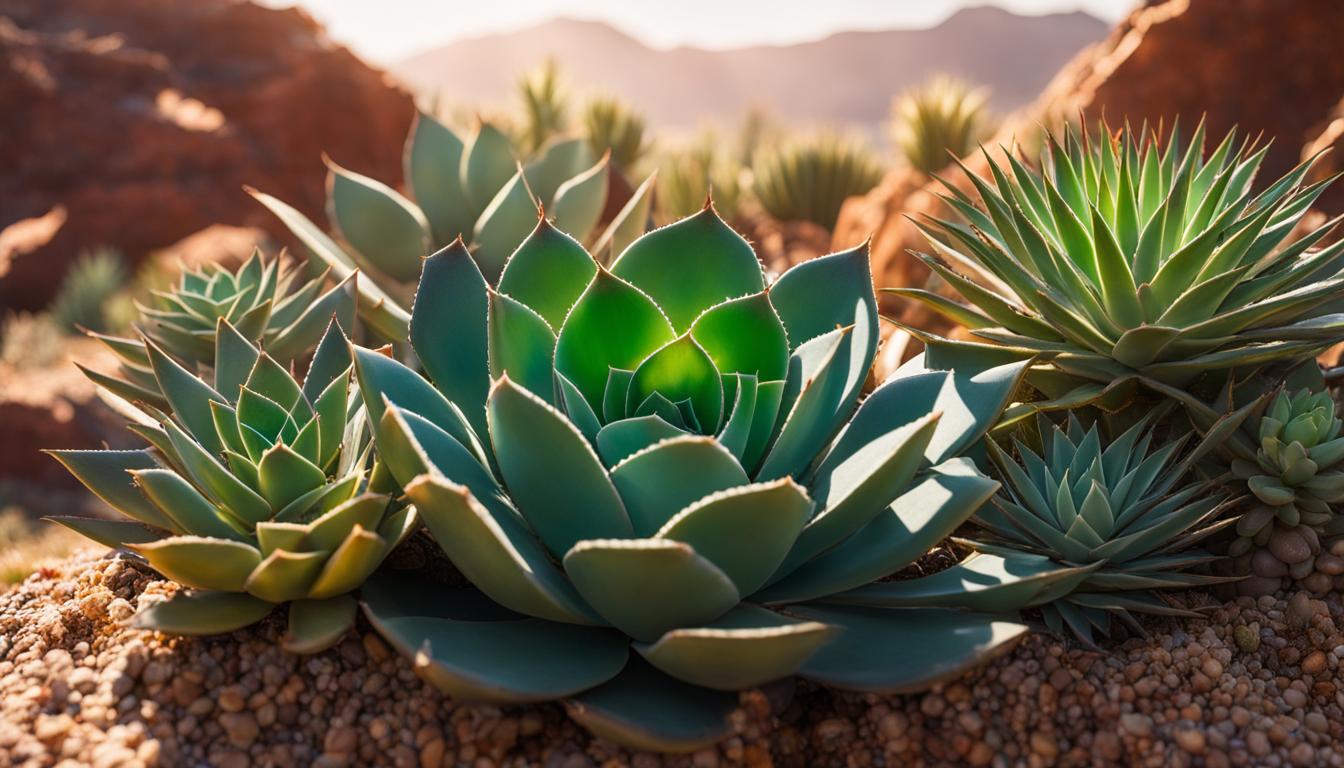Succulents are fascinating plants that have gained immense popularity due to their unique characteristics and ease of care. Whether you’re a seasoned plant enthusiast or just starting your plant journey, succulents are a wonderful addition to any indoor or outdoor space.
In this comprehensive guide, I will provide you with valuable insights and tips on succulent care, ensuring that your plants thrive and bring beauty to your surroundings. From the different types of succulents to best care practices, I’ve got you covered!
Key Takeaways:
- Learn about the different types of succulents and their care requirements.
- Discover the best practices for watering, sunlight exposure, and fertilizer application.
- Understand how to choose the right container and soil for your succulents.
- Gain insights into indoor and outdoor succulent care techniques.
- Explore advanced care techniques to take your succulent care to the next level.
What Makes Succulents Unique
Succulents have several unique features that allow them to thrive in arid environments. Their thick, fleshy leaves and stems are specially adapted to store water, allowing them to survive in dry conditions with minimal rainfall. These water storage structures enable succulents to withstand droughts and periods of low moisture. In addition to their water storage abilities, succulents have specialized leaf structures, such as spines and scales, which help reduce water loss through evaporation. These adaptations make succulents incredibly resilient and well-suited for both indoor and outdoor gardening. In this section, we will delve into the fascinating adaptations of succulents and explore how these features contribute to their unique beauty and survival mechanisms.
Adaptations for Arid Environments
Succulent plants have evolved various adaptations to thrive in arid environments. These adaptations allow them to survive and flourish in regions with limited water availability. Some of the key adaptations of succulents include:
- Water Storage: Succulents have developed the ability to store water in their leaves, stems, or roots. This water storage mechanism helps them endure prolonged periods of drought and low rainfall. The fleshy leaves and stems of succulents act as reservoirs, storing water for future use when water is scarce.
- Reduced Leaf Surface: Succulents often have thick and waxy leaves with a reduced surface area. This adaptation minimizes the exposure of succulents to the drying effects of the arid environment, reducing water loss through evaporation.
- Crassulacean Acid Metabolism (CAM): Many succulents employ a specialized form of photosynthesis called CAM, which allows them to open their stomata and exchange gases during the night when the temperatures are cooler and the evaporation rates are lower. This adaptation helps succulents conserve water while still carrying out essential metabolic functions.
- Spines and Scales: Some succulents have evolved spines or scales on their leaves or stems. These structures serve multiple purposes, including reducing water loss by creating a layer of insulation that traps moisture and shades the underlying tissues from the sun’s intense heat.
The combination of these unique adaptations enables succulents to thrive in arid environments where other plants would struggle to survive. Their ability to store water, reduce water loss, and adapt to low moisture conditions make succulents highly resilient and capable of withstanding challenging climates. This resilience, along with their diverse and striking leaf structures, contributes to the allure and popularity of these captivating plants.
Types of Succulents
Succulents are beloved for their diverse range of shapes, sizes, and colors, making them popular choices for both indoor and outdoor gardening. In this section, I will introduce you to some of the most popular succulent varieties that can add beauty and interest to your plant collection or garden.
Popular Succulent Varieties
1. Echeveria: These rosette-shaped succulents come in a variety of colors, from pale green to vibrant purples and blues. They are perfect for indoor succulent gardens or as stunning focal points in outdoor landscapes.
2. Aloe Vera: Known for its medicinal properties, aloe vera is a spiky succulent that thrives both indoors and outdoors. Its distinctive shape and soothing gel-filled leaves make it a popular choice for adding a touch of elegance to any space.
3. Hens and Chicks: This succulent variety, also known as sempervivum, forms beautiful rosettes and produces “chick” offsets around the main plant. Hens and chicks are drought-tolerant and can thrive in various environments, making them perfect for both outdoor gardens and containers.
4. Jade Plant: With its thick, round leaves and tree-like growth habit, the jade plant is often considered a symbol of good luck and prosperity. It is an excellent choice for indoor succulent collections or as a low-maintenance outdoor plant.
5. Snake Plant: Also known as Sansevieria or mother-in-law’s tongue, the snake plant is a hardy succulent with tall, upright leaves. It is well-suited for both indoor and outdoor areas and can thrive even in low-light conditions.
No matter your preference, these popular succulent varieties offer a wide range of options to suit your personal style and space. Below is a visually engaging table that provides a comparative overview of these succulent varieties, including their ideal growing conditions.

| Succulent Variety | Description | Ideal Growing Conditions |
|---|---|---|
| Echeveria | Rosette-shaped succulent with a variety of colors. | Full sun to bright filtered light; well-draining soil. |
| Aloe Vera | Spiky succulent known for its medicinal gel-filled leaves. | Bright indirect light to full sun; well-draining soil. |
| Hens and Chicks | Rosette-forming succulent with offset “chicks” around the main plant. | Full sun to light shade; well-draining soil. |
| Jade Plant | Thick-leaved succulent with a tree-like growth habit. | Bright indirect light to full sun; well-draining soil. |
| Snake Plant | Tall, upright succulent with striking, sword-shaped leaves. | Low to bright indirect light; well-draining soil. |
These succulent varieties are just a glimpse of the vast assortment available. With their unique beauty and care requirements, they can be a delightful addition to your home or garden. When selecting succulents, consider the growing conditions of your space and choose varieties that align with your preferences and gardening goals.
Caring for Succulents
Essential Succulent Care Tips
Proper care is essential for the health and growth of succulents. To ensure the success of your plants, it’s important to follow these essential succulent care tips:
- Watering succulents: Succulents have unique water storage abilities, and they prefer infrequent but deep watering. Allow the soil to dry out completely between waterings to prevent overwatering, which can lead to root rot.
- Sunlight for succulents: Succulents thrive in bright, indirect sunlight. Place them near a sunny window or in a spot with filtered sunlight. Avoid direct, intense sunlight as it can scorch the leaves.
- Succulent fertilizer: Feed your succulents with a balanced, low-nitrogen fertilizer during the growing season. Apply the fertilizer sparingly, following the package instructions, to avoid overfeeding.
- Succulent container choice: Use containers with drainage holes to prevent waterlogged soil. Choose shallow and wide containers that allow proper airflow around the roots.
- Succulent soil: Use a well-draining soil mix specifically formulated for succulents or make your own by combining potting soil with perlite or coarse sand.
- Succulent pest control: Monitor your succulents regularly for signs of pests like aphids, mealybugs, and spider mites. If infestation occurs, treat with organic insecticidal soap or neem oil.

By following these care tips, you’ll be able to create the optimal growing conditions for your succulents and maintain healthy and vibrant plants. Whether you’re new to succulent care or have experience with these unique plants, these essential tips will help you succeed in your succulent gardening journey.
Propagation & Growth
Propagation Methods for Succulents
Propagating succulents is a fascinating and rewarding process that allows you to expand your collection and share the joy of these beautiful plants with others. There are several propagation methods you can use to create new succulent plants, each with its own unique advantages and success rates. In this section, I will guide you through the step-by-step process of propagating succulents using various techniques.
Leaf Propagation
One of the most common and straightforward methods of succulent propagation is leaf propagation. To propagate succulents from leaves:
- Select a healthy and mature leaf from the parent plant.
- Detach the leaf from the stem by gently twisting and pulling it off.
- Allow the leaf to callus over for a few days to prevent rotting.
- Place the callused leaf on well-draining soil, either partially buried or laid flat on the surface.
- Mist the leaf occasionally to provide moisture.
- After a few weeks, roots will begin to develop, followed by tiny rosettes or new plants.
- Once the new plants have established roots, you can transplant them into their own pots.
Stem Propagation
Stem propagation is another effective method of succulent propagation that allows you to create new plants from stem cuttings. Here’s how to propagate succulents from stems:
- Choose a healthy and mature stem from the parent plant.
- Cut the stem cleanly with a sharp, sterile knife or scissors.
- Allow the cut end of the stem to dry and develop a callus for a couple of days.
- Plant the callused end of the stem in well-draining soil, burying it about an inch deep.
- Water the soil lightly, ensuring it is slightly moist but not soggy.
- Place the cutting in a bright location, but avoid direct sunlight.
- Within a few weeks, the cutting will form roots and start growing new leaves.
- Once the new plant becomes well-established, you can transfer it to a larger container or garden bed.
These two methods, leaf propagation and stem propagation, are the most commonly used techniques for propagating succulents. However, there are a few other propagation methods you can explore to expand your succulent collection.
Offsets
Offsets, also known as pups or babies, are small plants that naturally grow alongside the parent succulent plant. They can be gently removed and propagated, resulting in new, independent plants. To propagate succulents using offsets:
- Identify the offsets or pups growing near the base of the parent succulent.
- Gently separate the offset from the parent plant using clean hands or a sterile knife.
- Allow the separated offset to dry and develop a callus for a few days.
- Plant the callused offset in a well-draining soil mix, similar to the parent plant’s requirements.
- Water the soil lightly, keeping it slightly moist until the offset starts showing signs of growth.
- Over time, the offset will establish roots and develop into a new succulent plant.
Division
Division involves separating a mature succulent plant into smaller sections, each with its own roots and shoots. This method is commonly used for succulents that produce clumps or colonies. To propagate succulents through division:
- Carefully remove the mature succulent from its pot or garden bed.
- Gently separate the individual rosettes or sections, ensuring each has an adequate root system.
- Allow the separated sections to dry and develop calluses for a few days.
- Plant each section in separate containers or garden beds using well-draining soil.
- Water the soil lightly, allowing it to dry between waterings to prevent overwatering.
- With proper care, each section will establish roots and continue to grow as individual plants.
Cuttings
Cutting propagation involves taking a portion of a healthy succulent stem and creating a new plant from it. To propagate succulents from cuttings:
- Select a healthy and mature stem with several leaf nodes.
- Make a clean cut just below the leaf nodes using a sharp, sterile knife or scissors.
- Allow the cut end of the stem to dry and develop a callus for a couple of days.
- Plant the callused end of the stem in well-draining soil, with at least one or two nodes buried in the soil.
- Water the soil lightly, keeping it slightly moist while avoiding excess moisture.
- Place the cutting in a bright, indirect light location, avoiding direct sunlight.
- Over time, the cutting will form roots and grow new leaves, eventually becoming a mature succulent plant.
By exploring these different propagation methods for succulents, you can create an abundant collection of these stunning plants and share the joy of succulent gardening with others. With patience, proper care, and a little bit of experimentation, you’ll soon become an expert at propagating succulents and watching your plant collection thrive.

Advanced Care Techniques
Now that you have mastered the basics of succulent care, it’s time to elevate your gardening skills and take your succulent care to the next level. In this section, we will explore advanced care techniques that will help you fine-tune your succulent care routine and ensure the long-term health and vitality of your plants.
Grooming and Pruning
Grooming and pruning are essential aspects of advanced succulent care. Regularly inspect your succulents and remove any dead or yellowing leaves to maintain their aesthetic appeal. Pruning can also reshape your succulents and promote healthy growth.
Managing Dormancy Periods
Succulents go through dormancy periods where they reduce growth and conserve energy. Understanding and managing these dormant phases is crucial for their overall well-being. During dormancy, reduce watering and maintain cooler temperatures to mimic their natural environment.
Winter Care
As winter approaches, it’s important to adjust your care routine to protect your succulents from frost and cold temperatures. Move your outdoor succulents indoors or provide them with frost protection. Adjust watering and make sure they receive adequate light to prevent etiolation.
Promoting Flowering
Enjoy the beauty of your succulent’s flowers by learning how to promote flowering. Provide your succulents with the right amount of sunlight and temperature fluctuations to trigger their blooming cycle. Additionally, choose succulent varieties known for their vibrant and long-lasting flowers.
Preventing Diseases
Keep your succulents healthy by implementing disease prevention measures. Avoid overwatering, which can lead to root rot, and ensure proper air circulation to prevent fungal infections. Regularly inspect your plants for signs of pests and take prompt action if needed.
FAQ
What are succulents?
Succulents are plants known for their thick, fleshy leaves and low maintenance requirements. They have specialized water storage structures that allow them to survive in arid environments with minimal rainfall.
How do succulents adapt to arid environments?
Succulents have thick, fleshy leaves and stems that store water, enabling them to withstand droughts and periods of low moisture. They also have specialized leaf structures, such as spines and scales, that help reduce water loss through evaporation.
What are some popular succulent varieties?
Some popular succulent varieties include echeveria, aloe vera, hens and chicks, jade plant, and snake plant. Each variety has its own unique beauty and care requirements.
How should I care for my succulents?
To care for succulents, it’s important to provide them with adequate light and water, choose the right container and soil, and protect them from pests. Proper watering techniques, sunlight requirements, fertilization, and container choice are essential aspects of succulent care.
How can I propagate succulents?
Succulents can be propagated through various methods, including leaf propagation, stem propagation, offsets, division, and cuttings. Each method requires specific steps and techniques for optimal success.
What are some advanced care techniques for succulents?
Advanced care techniques for succulents include grooming and pruning, managing dormancy periods, winter care, promoting flowering, and preventing diseases. These techniques help maintain the health and vitality of your succulents.



Pingback: Living with Plants: Why Houseplants are Good for You – Trusted House Plant Guide